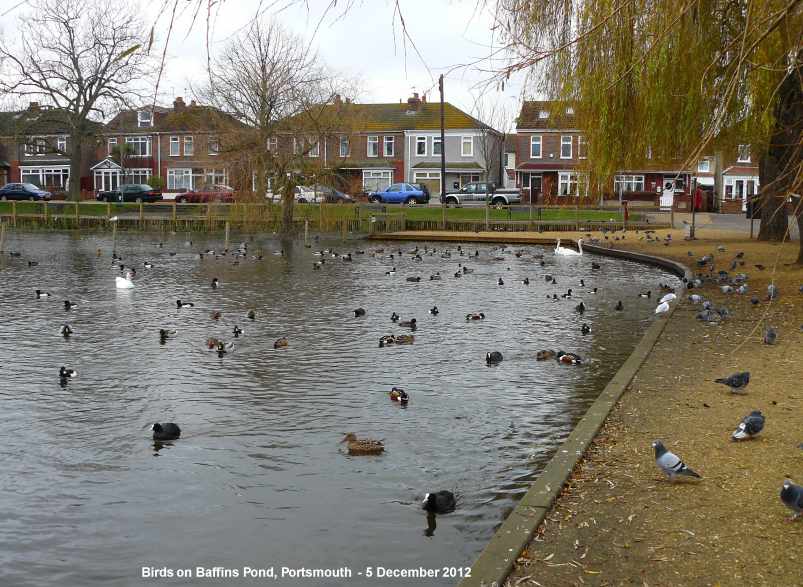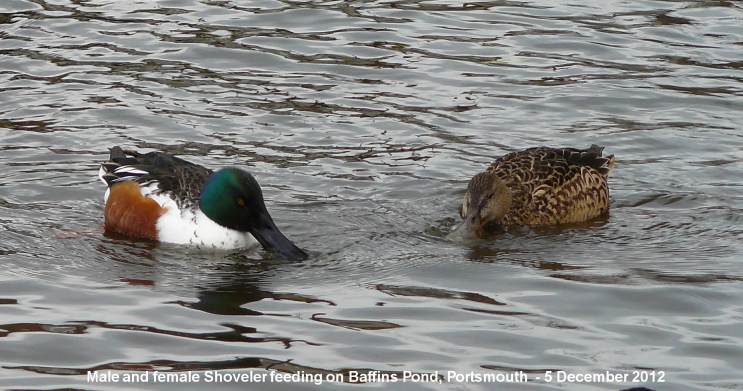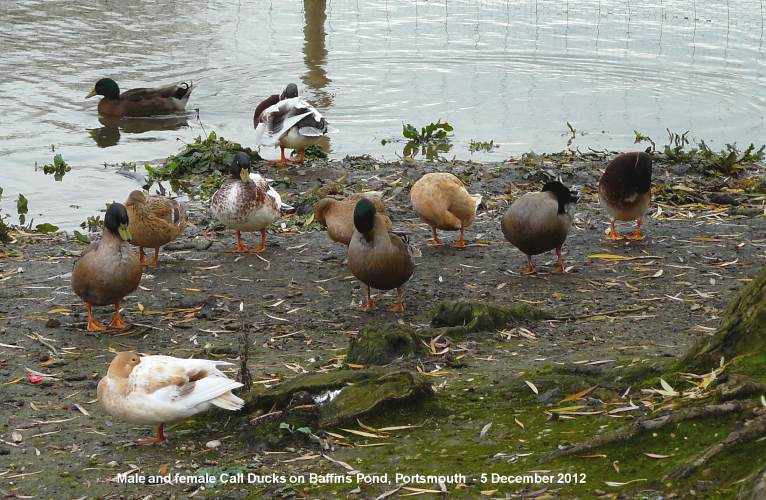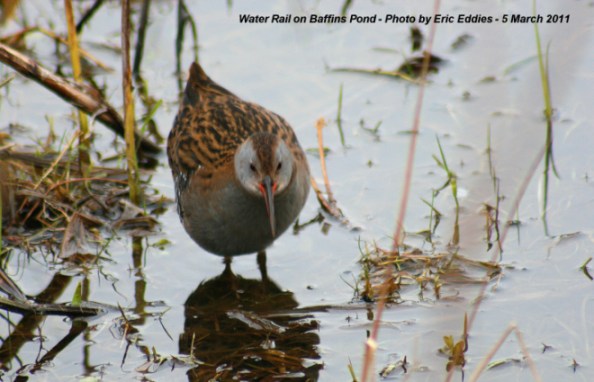BAFFINS
POND
A
personal history by Brian Fellows - written in
2009
I
first discovered Baffins Pond as a relative newcomer
to birdwatching in 1989 at the age of 53. I know many
birders turn their noses up at Baffins Pond as being
full of 'plastic' birds, but for me the pond was an
ideal venue to view a variety of birds at really close
range without the need for a telescope. Better still,
nobody else seemed to be watching the pond, so I had
it to myself!
I made regular weekly
visits for 14 years or so from 1992 until 2006,
counting and logging all the birds and sending my
records to the Hampshire Ornithology Society Recorder,
John Clark. In this time I not only got to know the
birds of the pond well, but also some of the local
residents and, in particular, George Benham who
greatly impressed me with his devotion to creating a
sense of community around the pond. Sadly, he died
soon after I stopped visiting the pond.
My favourite birds in
the early days were the Barnacle Geese. They
were not truly wild birds, but they were beautiful and
they were mine! From the winter of 1993-94 they went
on regular annual winter holidays to Titchfield Haven,
not far as the crow flies, and tt was there they got
the nickname the "Baffins Gang". They would stay for a
couple of months, but always came back home. Two Snow
Geese and a Bar-headed Goose also used to travel with
the gang in the early years, later to be joined by a
Hybrid Goose (Bar-headed x Snow?). In its hey day, in
the winter of 1998-99, the Barnacles were up to an
amazing 42, but by 2001-02 they were down to 10; now
there are just a few individuals remaining. They have
bred several times, most recently in 2006 I think, but
I doubt if any youngsters survived.
There were always some
Canada Geese on the pond throughout the year,
but I always used to look forward with excitement to
the arrival of the large flock on their annual moult
migration in June and July. Numbers were normally
around 150, but in June 2003 I counted an astonishing
273. They were a fine spectacle.
The pond had a pair of
resident Mute Swans that nested on the main
island and they often managed to produce a few
youngsters, though I suspect the survival rate was
poor. Looking through old Hampshire Bird Reports, I
was surprised to see there used to be a sizeable flock
of Mute Swans on the pond in the 1980s with 89 being
recorded in Feb 1991, but from 1993 onwards 5 was the
most I ever saw. Strange how the habits of Mute Swans
change. The same thing happened at Canoe Lake,
Southsea, where I used to find wintering flocks of up
to 90 Mute Swans in the late 1990s and early 2000s,
but they had all but disappeared from about 2004. Was
this due to an edict not to feed with bread?
Shoveler were
(and still are) regular winter visitors to the pond.
The most I ever counted was 72, but Bob Chapman holds
the record of 83 on 22nd November 2001. I always
enjoyed watching them feeding in their strange
circling fashion. Why do they do that?
Cormorants were
a feature of the pond, often loafing on the main
island. Apparently, Baffins Pond used to be an
important venue for fishermen until, I think, the
Council put a stop to it.
The other resident
water birds were Little Grebe (up to 5),
Grey Heron (one), Embden Geese (2 or 3),
Mallard (over 250 in late 1980s, but down to
about 100 nowadays), Tufted Duck (mainly a
winter visitor with a maximum of 93 in Feb 2005, but
also occasionally breeding), Coot (high 30s in
early 1990s, but down to 25 or so in 2002) and
Moorhen (maximum of 22).
I have also recorded
Brent Goose, Pochard, Red-crested Pochard, Shelduck,
but only infrequently.
Probably, the most
famous bird of Baffins Pond was the highly confiding
Water Rail, which provided lots of visiting
birders with excellent photo opportunities in March
2001 and again in 2003, when it was joined by a second
bird. There has been no sign of them since then.
As for rare birds, I
got very excited by what I thought was a Ferruginous
Duck in October 2004, but sadly it turned out to be a
female Rosybill, an escaped exotic duck. This
bird was still on the pond in February 2005 when I
came across another exotic duck, a Chiloe Wigeon
which I had previously seen on Peter Pond in
Emsworth.
Other 'plastic' birds
on the pond at various times included Lesser
White-fronted Goose (in early 1990s), Black Swan,
Emperor Goose and Muscovy Duck. I believe the Council
stocked the pond with a variety of ornamental
waterfowl in the 1960s. A friend's photos taken at
that time shows Greylag Goose, Swan (Chinese) Goose,
Egyptian Goose, Mandarin, Pintail and Wood Duck,
though I did not see any of these during my time on
the pond.
DIARY
OF MORE RECENT VISITS
Wednesday
December 5 - 2012
I did not do a proper
count but noted the folowing birds on the pond this
morning: Cormorant 4, Mute Swan 2, Embden Goose 1,
Tufted Duck 60, Mallard 100+, Shoveler 30, Feral
Pigeon 100+, I was suprised to find no Canada Geese at
all.

The Shoveler were
feeding in their distinctive fashion, usually in
male-female pairs, circling around sieving food
particles from the water.

I happened to meet my
friend Eric Eddles who lives near the pond and it is a
regular birdwatching site for him. He told me the Mute
Swan pair had a successful breeding season producing 7
cygnets all of which survived. He said Canada Geese
were quite rare on the pond except during moult in
July.
Call
Ducks
Most interestingly,
Eric showed me some newcomers to the pond, called Call
Ducks, which I had not only never seen before, but
never actually heard of. He said there were about 10
of them, both males and females, but just how they
came to be on the pond he is not sure. The males were
Mallard-like with dark heads and white on the flanks;
the more attractive females had pale orange plumage
and orange legs and feet, as shown in the following
photos.


From the internet I
learned that the Call Duck is a bantam breed of
domesticated duck raised primarily for decoration or
as pets. They look similar to Mallards, but are
smaller in size. They were first used in the
Netherlands as decoys, their high-pitched distinctive
call luring other ducks into funnel traps. However,
now they are mainly a domestic species kept as pets.
There is actually a British Call Duck Club to promote
interest and good management of these popular ducks.
See . . . http://www.britishcallduckclub.org.uk/
This web site
indicates there is a variety of breeds of Call Duck.
WATER
RAIL RETURNS - March 2011
Water Rail is bird I
remember very well from my years watching the wildlife
on Baffins Pond from 1992 to 2006.
I recall my
astonishment when this normally secretive and hard to
see bird suddenly appeared on the path right in front
of me on the southern side of the pond on 6 Mar 2001.
I saw it regularly for the next couple of weeks and
local people used to give it food.
I did not see the
Water Rail again until February-March 2003, when there
was not just one bird, but two! Local wildlife
photographers flocked to the pond to get a lifetime
best image of these very confiding birds, though I
recall only one bird regularly came onto the path. I
did not see them again, though my visits to Baffins
Pond became infrequent after 2006.
I was very pleased to
hear from local Baffins resident Eric Eddies (in Feb
2012) that a Water Rail was back on the pond in 2011,
in much the same place as before and just as
confiding. As the expected life span of a Water Rail
is only up to 7 years, this is unlikely to be the same
bird as the one that was there in 2003. Eric sent me
some photos taken of the bird on the south side of
Baffins Pond on Saturday and Sunday the 5th and 6th of
March 2011. I have asked him to keep a special watch
this year just in case it returns.





